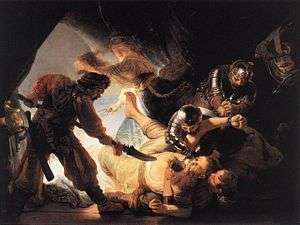Blinding (punishment)

Blinding is a type of physical punishment which results in complete or nearly complete loss of vision. It has been used as an act of vengeance and torture.[1]
The method has been known since Antiquity. The Greek mythology makes several references to blinding as divine punishment, which reflects human practice.
Examples :
1. Oedipus, who gouged out his own eyes after accidentally fulfilling the prophecy that he would end up killing his father and marrying his mother.[2] In the Bible, Samson was blinded upon his capture by the Philistines.[3]
2. Early Christians were often blinded as a penalty for their beliefs.[4] For example, St. Lucy's torturers tore out her eyes.
3. In the Middle Ages, blinding was used as a penalty for treachery or as a means of rendering a political opponent unable to rule and lead an army in war.[5] In the 11th century, William the Conqueror used blinding as a punishment for rebellion to replace the death penalty in his laws for England
4. Blinding was a punishment for killing a hart or hind in a royal forest.
5. Henry I of England blinded William, Count of Mortain, who had fought against him at Tinchebray in 1106. He also ordered blinding and castration as a punishment for thieves.[5]
6. In 1014, the Byzantine emperor Basil II had 99 of every 100 captured Bulgarians blinded, leaving 150 one-eyed men to lead them back to their commander.[1]
7. Bela-II-of-Hungary and his father was blinded by king-Coloman-of-hungary
8. Blinding survives as a form of penalty in the modern era, especially as part of the sharia law. In 2003, a Pakistani court sentenced a man to be blinded after he subjected his fiancee to an acid attack resulting in loss of vision.
9. Blinding-punishment was given by an Iranian court in 2009 for a man who blinded Ameneh Bahrami in an acid attack; Bahrami eventually pardoned the attacker.[1]
Blinding was accomplished by gouging out the eyes, sometimes using a hot poker, and by pouring a boiling substance, such as vinegar, on them.[6]
See also
References
- 1 2 3 Goes, Frank Joseph (2013). The Eye in History. JP Medical Ltd. p. 234. ISBN 9350902745.
- ↑ Rose, Martha L. (2003). The Staff of Oedipus: Transforming Disability in Ancient Greece. University of Michigan Press. pp. 81–82. ISBN 0472113399.
- ↑ Hartsock, Chad (2008). Sight and Blindness in Luke-Acts: The Use of Physical Features in Characterization. Brill. p. 107. ISBN 9004165355.
- ↑ Pearman, Tory Vandeventer (2010). Women and Disability in Medieval Literature. Palgrave Macmillan. p. 89. ISBN 0230117562.
- 1 2 Evans, Michael (2007). The Death of Kings: Royal Deaths in Medieval England. A&C Black. pp. 37, 89–90. ISBN 1852855851.
- ↑ Lawler, Jennifer (2004). Encyclopedia of the Byzantine Empire. McFarland. p. 106. ISBN 1476609292.